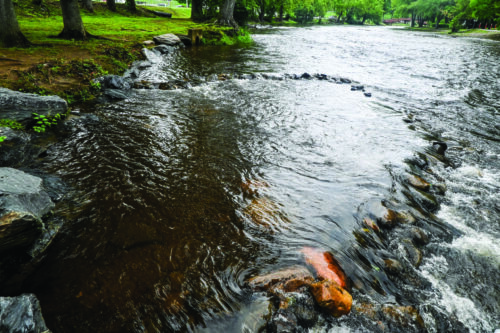By MATTILYNN SNEED
Cherokee One Feather Intern Reporter
CHEROKEE, N.C.- In the heart of downtown Cherokee lies the Oconaluftee Island Park. Along the riverbanks, park visitors frequently build wading pools and stack rocks out of the water. These rock structures may seem harmless, but their environmental impact can’t be ignored.

A rock wading pool, approximately 12-feet wide constructed by visitors, is shown at the Oconaluftee Island Park. (MATTILYNN SNEED/One Feather photo)
The Oconaluftee River is inhabited by a diverse ecosystem, and disturbing the rocks affects several aquatic species. The fish that live in the river depend on mayflies, stoneflies and caddisflies as a food source. These insects lay their eggs on the bottoms of rocks. When the rocks are stacked above the water level, the eggs dry out, killing them and breaking the lifecycle. Fish are affected even more directly when the eggs they lay beneath the rocks are exposed to predators.
“The issue isn’t that a few kids are moving rocks, it’s that we’re next to the most visited national park in the country, and that park brings in 13 million people a year. Those millions of people result in thousands on the island. If it was just local Cherokee people doing it, it wouldn’t be that much of a problem. At the scale we’re seeing, it’s going to cause big eco system shifts, and we are concerned about that,” EBCI Fish and Wildlife Biologist Caleb Hickman said.
The eastern hell bender is another species negatively impacted by rock disturbance. This salamander is listed as endangered by the National Park Service, and moving the rocks that they call home can kill them and expose their eggs to predators.
Signage at the Island Park informs fisherman of what to do if they catch a hellbender on their line, but there is no signage that informs visitors of how rock disruption affects the hellbenders and other wildlife. Michael LaVoi, the EBCI Natural Resources director, says they are collaborating with the Division of Commerce to erect signs informing visitors of why rock disturbance is detrimental.
While the Indian Mineral Leasing Act of 1938 makes it illegal for non-enrolled people to remove rocks from the Boundary, there are currently no ordinances that prevent people from disturbing the stones in the river. Hickman said he thinks an ordinance for Island Park visitors, such as the one that forbids the disturbance of river rocks in the Smoky Mountain National Park, would be beneficial to the health of the river. He went on to advise that people who wish to lend a hand in preserving the watershed’s ecosystem should dismantle these structures and return the rocks to the water. “My other piece of advice to locals is to inform visitors who don’t know any better. Be good stewards, because it’s your watershed.”





